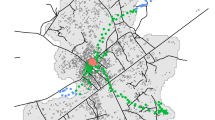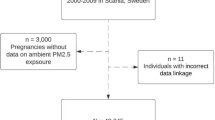Abstract
Prenatal air pollution exposure is frequently estimated using maternal residential location at the time of delivery as a proxy for residence during pregnancy. We describe residential mobility during pregnancy among 19,951 children from the Kaiser Air Pollution and Pediatric Asthma Study, quantify measurement error in spatially resolved estimates of prenatal exposure to mobile source fine particulate matter (PM2.5) due to ignoring this mobility, and simulate the impact of this error on estimates of epidemiologic associations. Two exposure estimates were compared, one calculated using complete residential histories during pregnancy (weighted average based on time spent at each address) and the second calculated using only residence at birth. Estimates were computed using annual averages of primary PM2.5 from traffic emissions modeled using a Research LINE-source dispersion model for near-surface releases (RLINE) at 250 m resolution. In this cohort, 18.6% of children were born to mothers who moved at least once during pregnancy. Mobile source PM2.5 exposure estimates calculated using complete residential histories during pregnancy and only residence at birth were highly correlated (rS>0.9). Simulations indicated that ignoring residential mobility resulted in modest bias of epidemiologic associations toward the null, but varied by maternal characteristics and prenatal exposure windows of interest (ranging from −2% to −10% bias).
This is a preview of subscription content, access via your institution
Access options
Subscribe to this journal
Receive 6 print issues and online access
$259.00 per year
only $43.17 per issue
Buy this article
- Purchase on Springer Link
- Instant access to full article PDF
Prices may be subject to local taxes which are calculated during checkout



Similar content being viewed by others
References
Pereira G, Bracken MB, Bell ML . Particulate air pollution, fetal growth and gestational length: the influence of residential mobility in pregnancy. Environ Res 2016; 147: 269–274.
Saadeh FB, Clark MA, Rogers ML, Linkletter CD, Phipps MG, Padbury JF et al. Pregnant and moving: understanding residential mobility during pregnancy and in the first year of life using a prospective birth cohort. Matern Child Health J 2013; 17: 330–343.
Chen L, Bell EM, Caton AR, Druschel CM, Lin S . Residential mobility during pregnancy and the potential for ambient air pollution exposure misclassification. Environ Res 2010; 110: 162–168.
Miller A, Siffel C, Correa A . Residential mobility during pregnancy: patterns and correlates. Matern Child Health J 2010; 14: 625–634.
Canfield MA, Ramadhani TA, Langlois PH, Waller DK . Residential mobility patterns and exposure misclassification in epidemiologic studies of birth defects. J Expo Sci Environ Epidemiol 2006; 16: 538–543.
Zender R, Bachand AM, Reif JS . Exposure to tap water during pregnancy. J Expo Anal Environ Epidemiol 2001; 11: 224–230.
Lupo PJ, Symanski E, Chan W, Mitchell LE, Waller DK, Canfield MA et al. Differences in exposure assignment between conception and delivery: the impact of maternal mobility. Paediatr Perinat Epidemiol 2010; 24: 200–208.
Bell ML, Belanger K . Review of research on residential mobility during pregnancy: consequences for assessment of prenatal environmental exposures. J Expo Sci Environ Epidemiol 2012; 22: 429–438.
DeFranco E, Hall E, Hossain M, Chen A, Haynes EN, Jones D et al. Air pollution and stillbirth risk: exposure to airborne particulate matter during pregnancy is associated with fetal death. PLoS One 2015; 10: e0120594.
Capobussi M, Tettamanti R, Marcolin L, Piovesan L, Bronzin S, Gattoni ME et al. Air pollution impact on pregnancy outcomes in Como, Italy. J Occup Environ Med 2016; 58: 47–52.
Hannam K, McNamee R, Baker P, Sibley C, Agius R . Air pollution exposure and adverse pregnancy outcomes in a large UK birth cohort: use of a novel spatio-temporal modelling technique. Scand J Work Environ Health 2014; 40: 518–530.
Lee PC, Roberts JM, Catov JM, Talbott EO, Ritz B . First trimester exposure to ambient air pollution, pregnancy complications and adverse birth outcomes in Allegheny County, PA. Matern Child Health J 2013; 17: 545–555.
Hodgson S, Lurz PW, Shirley MD, Bythell M, Rankin J . Exposure misclassification due to residential mobility during pregnancy. Int J Hyg Environ Health 2015; 218: 414–421.
Brokamp C, LeMasters GK, Ryan PH . Residential mobility impacts exposure assessment and community socioeconomic characteristics in longitudinal epidemiology studies. J Expo Sci Environ Epidemiol 2016; 26: 428–434.
Georgia Department of Public Health, Office of Health Indicators for Planning (OHIP). Online Analytical Statistical Information System: Demographic Clusters of Georgia: Accessing the Georgia Department of Public Health's Data Warehouse. Available from https://oasis.state.ga.us/gis/demographiccluster/DemoClusters2011.htm. Accessed 11 April 2016.
Community Modeling and Analysis System. R-LINE: A Research LINE-source dispersion model for near-surface releases. Available from https://www.cmascenter.org/r-line/. Accessed 28 September 2015.
Atlanta Regional Commission. AREES - Near Road Emissions. Available from http://atlantaregional.com/environment/air/arees-near-road-emissions. Accessed 6 May 2016.
Cimorelli AJ, Perry SG, Venkatram A, Weil JC, Paine RJ, Wilson RB et al. AERMOD: a dispersion model for industrial source applications. Part I: general model formulation and boundary layer characterization. J Appl Meteorol 2005; 44: 682–693.
U.S. Environmental Protection Agency. EPA-CMB8.2 Users Manual. Report No. EPA-452/R-04-011. December 2004. Research Triangle Park, NC.
R Core Team R: A Language and Environment for Statistical Computing. R Foundation for Statistical Computing: Vienna, Austriahttp://www.R-project.org2014.
Khoury MJ, Stewart W, Weinstein A, Panny S, Lindsay P, Eisenberg M . Residential mobility during pregnancy: implications for environmental teratogenesis. J Clin Epidemiol 1988; 41: 15–20.
Schulman J, Selvin S, Shaw GM, Malcoe LH . Exposure misclassification due to residential mobility during pregnancy in epidemiologic investigations of congenital malformations. Arch Environ Health 1993; 48: 114–119.
Iniguez C, Ballester F, Estarlich M, Llop S, Fernandez-Patier R, Aguirre-Alfaro A et al. Estimation of personal NO2 exposure in a cohort of pregnant women. Sci Total Environ 2009; 407: 6093–6099.
Acknowledgements
Support for this work was provided by US EPA Grant R834799, NIH/NICHD Grant R03HD084884-01, and NIH Reproductive, Perinatal, & Pediatric Training Grant T32HD052460. This publication’s contents are solely the responsibility of the grantee and do not necessarily represent the official view of the US EPA. Furthermore, US EPA does not endorse the purchase of any commercial products or services mentioned in the publication.
Author information
Authors and Affiliations
Corresponding author
Ethics declarations
Competing interests
The authors declare no conflict of interest.
Additional information
Supplementary Information accompanies the paper on the Journal of Exposure Science and Environmental Epidemiology website
Supplementary information
Rights and permissions
About this article
Cite this article
Pennington, A., Strickland, M., Klein, M. et al. Measurement error in mobile source air pollution exposure estimates due to residential mobility during pregnancy. J Expo Sci Environ Epidemiol 27, 513–520 (2017). https://doi.org/10.1038/jes.2016.66
Received:
Revised:
Accepted:
Published:
Issue Date:
DOI: https://doi.org/10.1038/jes.2016.66
Keywords
This article is cited by
-
Wildfire smoke exposure and early childhood respiratory health: a study of prescription claims data
Environmental Health (2023)
-
Effects of air pollution on adverse birth outcomes and pregnancy complications in the U.S. state of Kansas (2000–2015)
Scientific Reports (2023)
-
Assessing air pollution exposure misclassification using high-resolution PM2.5 concentration model and human mobility data
Air Quality, Atmosphere & Health (2023)
-
Both parents matter: a national-scale analysis of parental race/ethnicity, disparities in prenatal PM2.5 exposures and related impacts on birth outcomes
Environmental Health (2022)
-
Exposure measurement error and the characterization of child exposure to fecal contamination in drinking water
npj Clean Water (2020)



